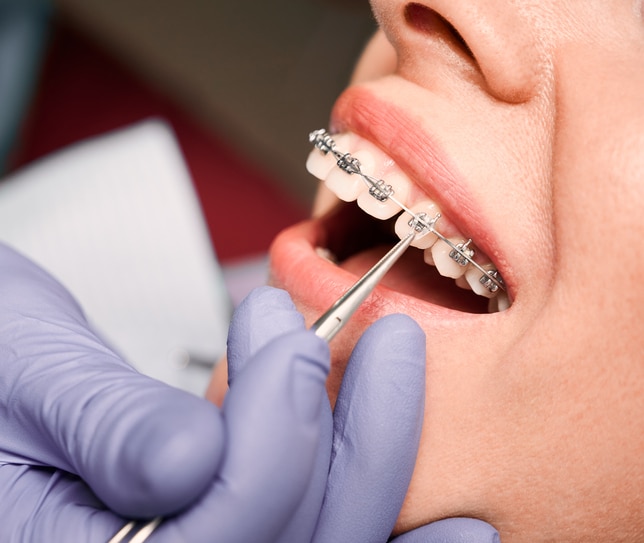How Cumming Orthodontics Addresses Common Braces and Invisalign Problems
How Cumming Orthodontics Addresses Common Braces and Invisalign Problems
Blog Article
Comprehensive Overview to Orthodontics Procedures for Fixing Oral Misalignments
Understanding the complexities of each treatment, including their devices, benefits, and potential drawbacks, is crucial in making informed decisions about one's orthodontic therapy. As we browse with the thorough overview to orthodontic treatments for remedying oral imbalances, the intricate details of each method will certainly unfold, shedding light on the path towards a practical and harmonious oral positioning.
Orthodontic Procedures Introduction

In addition to traditional dental braces and clear aligners, orthodontists may likewise recommend other interventions like headgear, palatal expanders, or retainers to deal with particular placement issues (orthodontist). These treatments are tailored per patient's special demands and may entail a combination of treatments to achieve the desired results. Routine changes and monitoring are essential components of orthodontic therapy to make sure progress gets on track and to make any kind of needed modifications in the process. By undertaking orthodontic treatments, people can not only achieve a straighter smile yet additionally enhance their total dental health and wellness and function.
Typical Dental Braces: How They Function
When taking into consideration orthodontic therapies for dental misalignments, standard dental braces stand out as a tried and true method for dealing with teeth positioning. Traditional dental braces are composed of brackets, cords, and bands that function with each other to use constant stress on the teeth, gradually moving them right into the desired placement.
As pressure is applied to the teeth with the braces, the bone surrounding the teeth is reshaped to sustain the new tooth positions. Individuals will certainly require normal changes at the orthodontist's workplace to make sure the dental braces proceed to apply the appropriate stress for effective teeth motion.
Invisible Aligners: Disadvantages and pros
These clear, customized trays are practically undetectable when put on, making them an appealing choice for individuals looking for a more visually pleasing orthodontic therapy. Individuals can eliminate the aligners before consuming or brushing their teeth, decreasing the danger of food obtaining stuck in the appliance and streamlining the cleansing process.

Surgical Orthodontic Options
Surgical interventions in orthodontics present feasible options for dealing with intricate dental imbalances that might not be effectively solved with traditional orthodontic treatments. While unnoticeable aligners and conventional dental braces can remedy several orthodontic issues, certain cases need medical intervention to achieve optimal results. Surgical orthodontic choices are typically advised for extreme malocclusions, significant jaw disparities, and cases where the underlying bone structure requires adjustment to attain proper placement.
One common surgical orthodontic treatment is orthognathic surgical procedure, which involves repositioning the jaws to remedy practical problems such as problem chewing or talking. This surgery is often done in partnership with an orthodontist who assists line up the teeth before and after the procedure. Surgical orthodontics might also entail procedures to reveal impacted teeth, eliminate excess periodontal cells, or reshape the jawbone to create a more unified facial account.
Prior to thinking about medical orthodontic choices, individuals undergo an extensive analysis to determine the requirement and possible advantages of such interventions. orthodontist. While surgery may appear overwhelming, it can considerably boost both the feature and looks of the smile in instances where standard orthodontic therapies fail
Retainers and Post-Treatment Care

Failing to conform with post-treatment treatment instructions can result in regression, where the teeth slowly relocate back towards their initial positions. Regular retainer wear, great oral hygiene, and routine oral exams are crucial for keeping the results achieved with orthodontic surgery and making sure the lasting security of the fixed dental placement.
Conclusion
In conclusion, orthodontic treatments supply numerous options for correcting dental misalignments. Standard dental braces utilize metal brackets and wires to shift teeth into correct alignment. Undetectable aligners offer a more very discreet choice but might not appropriate for all cases. Surgical orthodontic choices are offered for a lot more severe imbalances. Retainers are generally utilized post-treatment to preserve the brand-new alignment. On the whole, orthodontic treatments can successfully boost oral wellness and visual appearance.
As we browse through the comprehensive guide to orthodontic procedures for fixing dental misalignments, the intricate details of each method will unravel, shedding light on the course toward a unified and practical dental placement. - cumming orthodontics
One of the most common orthodontic therapies is the use of dental braces, which are composed of steel braces and cords that use mild pressure to progressively move teeth into the wanted position.When considering orthodontic treatments for dental imbalances, typical braces stand out as a tried and true approach for fixing teeth positioning. In addition, undetectable aligners might not be ideal for complex orthodontic problems that need more significant teeth motion, as they are normally suggested for moderate to moderate instances. Retainers are personalized orthodontic devices developed to hold teeth in their corrected positions after the conclusion of orthodontic therapy.
Report this page